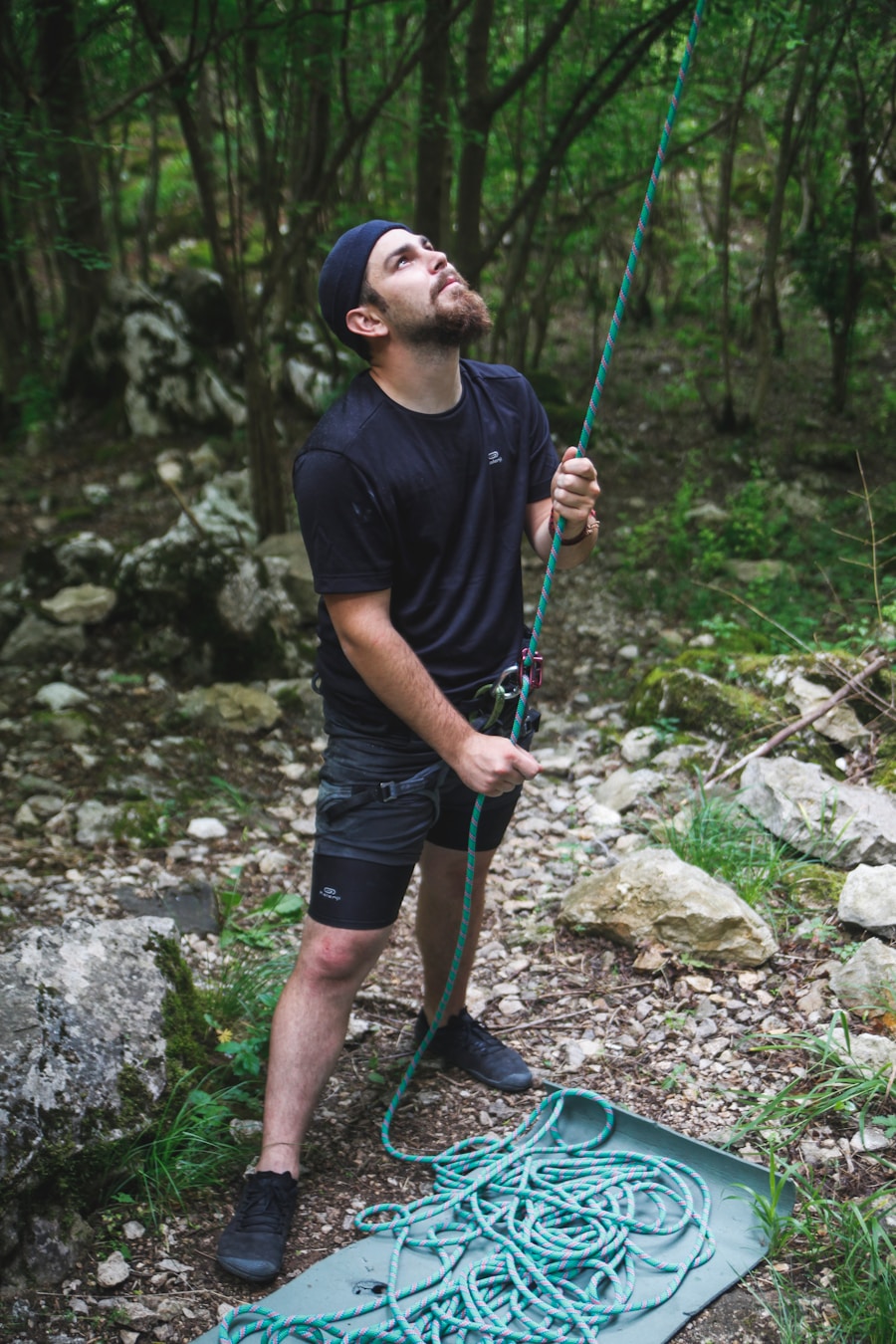Hiking sticks, often referred to as trekking poles, have gained popularity among outdoor enthusiasts for a multitude of reasons. One of the primary benefits is the enhanced stability they provide on uneven terrain. When traversing rocky paths, steep inclines, or slippery surfaces, hiking sticks can significantly reduce the risk of falls.
By distributing weight more evenly and providing additional points of contact with the ground, they help maintain balance and stability. This is particularly beneficial for individuals who may have mobility issues or those who are new to hiking and may not yet have developed the necessary skills to navigate challenging landscapes. In addition to stability, hiking sticks can also alleviate strain on the joints, particularly the knees.
When descending steep trails, the impact on the knees can be substantial, leading to discomfort or even injury over time. By using trekking poles, hikers can transfer some of their weight from their legs to their arms, effectively reducing the load on their knees. This redistribution of weight not only enhances comfort but can also prolong a hiker’s endurance on longer treks.
Furthermore, studies have shown that using hiking sticks can improve overall cardiovascular performance by engaging the upper body, leading to a more balanced workout during hikes.
Key Takeaways
- Hiking sticks provide added stability and support, reducing strain on joints and muscles
- Choosing the right hiking sticks involves considering material, weight, grip, and adjustability
- Proper technique for using hiking sticks includes adjusting the length, using a natural arm swing, and planting the sticks at an angle
- Hiking stick maintenance involves cleaning, checking for damage, and storing properly
- Hiking stick alternatives include trekking poles, walking staffs, and even using natural materials like sturdy branches
How to Choose the Right Hiking Sticks for You
Selecting the appropriate hiking sticks involves considering several factors that cater to individual needs and preferences. One of the first aspects to evaluate is the material of the poles. Hiking sticks are typically made from aluminum or carbon fiber.
Aluminum poles are known for their durability and affordability, making them a popular choice for casual hikers. On the other hand, carbon fiber poles are lighter and absorb shock better, which can be advantageous for those who plan to hike frequently or over long distances. Understanding your hiking style and frequency can guide you in choosing between these materials.
Another critical factor is the adjustability of the poles. Many hiking sticks come with adjustable lengths, allowing users to customize them according to their height and the terrain they are navigating. A general rule of thumb is that when standing upright with the poles, your elbows should form a 90-degree angle.
Fixed-length poles may be suitable for those who hike in similar conditions regularly, but adjustable poles offer versatility for varying terrains and user heights. Additionally, consider features such as grips and straps; ergonomic grips made from cork or foam can enhance comfort during long hikes, while wrist straps provide added security and prevent accidental drops.
Proper Technique for Using Hiking Sticks

Mastering the proper technique for using hiking sticks can significantly enhance their effectiveness and ensure a safer hiking experience. When using trekking poles, it is essential to maintain a natural arm swing that mimics your walking motion. As you step forward with one leg, the opposite pole should move forward simultaneously.
This coordinated movement helps maintain balance and rhythm while walking. It is crucial to avoid overreaching with the poles; instead, plant them firmly on the ground at a comfortable distance in front of you to maximize stability. When ascending or descending hills, adjusting your technique is vital.
While climbing uphill, it is beneficial to use the poles to push against the ground, providing extra propulsion and support.
Conversely, when descending, hikers should lean slightly back and use the poles to help control their descent. This technique not only reduces strain on the knees but also allows for better control over speed and stability on steep slopes.Practicing these techniques on varied terrain can help hikers become more adept at using their sticks effectively.
Hiking Stick Maintenance and Care
| Aspect | Recommendation |
|---|---|
| Cleaning | Wipe down the hiking stick with a damp cloth after each use to remove dirt and debris. |
| Storage | Store the hiking stick in a dry place away from direct sunlight to prevent warping or damage. |
| Inspecting | Regularly check for any cracks, splinters, or loose parts that may need repair or replacement. |
| Protective Coating | Apply a protective coating, such as varnish or sealant, to maintain the integrity of the hiking stick. |
| Replacement | If the hiking stick shows signs of significant wear or damage, consider replacing it for safety reasons. |
Proper maintenance of hiking sticks is essential for ensuring their longevity and optimal performance. After each hike, it is advisable to clean the poles thoroughly to remove dirt, mud, and debris that may have accumulated during your trek. A simple wipe-down with a damp cloth can suffice for most materials; however, if your poles are particularly dirty, a mild soap solution may be necessary.
Pay special attention to the tips and baskets of the poles, as these areas often collect grime that can affect grip and performance. In addition to regular cleaning, inspecting your hiking sticks for any signs of wear or damage is crucial. Check for cracks in carbon fiber poles or bends in aluminum ones, as these can compromise their structural integrity.
The locking mechanisms should also be examined to ensure they function correctly; a faulty lock can lead to unexpected collapses during use. If you notice any issues, it may be worth consulting with a professional or considering replacement parts rather than risking injury on your next hike.
Hiking Stick Alternatives
While hiking sticks offer numerous benefits, they are not the only tools available for enhancing stability and support during hikes. One popular alternative is the use of a walking staff or cane, which can provide similar support without the need for two separate poles. Walking staffs are often made from wood or lightweight materials and can be particularly appealing for those who prefer a more traditional approach to hiking support.
Another alternative is using a backpack with built-in support features. Some modern backpacks come equipped with frames that provide additional stability while carrying gear. These backpacks can help distribute weight more evenly across the body, reducing strain on the back and legs during long hikes.
Additionally, some hikers opt for natural elements found along the trail as makeshift walking aids; sturdy branches or fallen logs can serve as temporary supports in emergencies or when trekking through particularly challenging areas.
Common Misconceptions About Hiking Sticks

Despite their growing popularity, several misconceptions about hiking sticks persist among outdoor enthusiasts. One common belief is that trekking poles are only necessary for older hikers or those with physical limitations. In reality, hikers of all ages and skill levels can benefit from using hiking sticks.
They enhance balance and stability for everyone, making them valuable tools for both novice hikers navigating their first trails and seasoned adventurers tackling challenging terrains. Another misconception is that using hiking sticks slows down your pace or makes hiking more cumbersome. While it may take some time to adjust to using poles effectively, many hikers find that they can maintain or even increase their speed once they become accustomed to the rhythm of pole use.
The added support allows for more confident movement over difficult terrain, which can lead to improved overall efficiency during hikes.
Hiking Stick Safety Tips
Safety should always be a priority when using hiking sticks in outdoor environments. One essential tip is to ensure that your poles are properly adjusted before setting out on your hike. Incorrectly sized poles can lead to discomfort or even injury over time.
Additionally, when navigating steep descents or rocky paths, it is crucial to plant your poles firmly before shifting your weight onto them; this practice helps prevent slips and falls. Another important safety consideration is awareness of your surroundings while using trekking poles. Hikers should remain vigilant about potential hazards such as loose rocks or uneven ground that could cause accidents.
It’s also wise to avoid using trekking poles in areas where they could become entangled in vegetation or other obstacles. By maintaining focus on both your footing and your pole placement, you can enhance your safety while enjoying the benefits of hiking sticks.
Environmental Impact of Hiking Sticks
The environmental impact of hiking sticks is an often-overlooked aspect of outdoor gear usage. Many trekking poles are manufactured from materials such as aluminum or carbon fiber, which require significant energy resources for production and transportation. Additionally, some hiking stick manufacturers may not prioritize sustainable practices in their supply chains, leading to increased carbon footprints associated with their products.
However, there are eco-friendly options available for environmentally conscious hikers. Some brands produce trekking poles made from recycled materials or sustainably sourced wood. Choosing such products not only supports sustainable practices but also encourages manufacturers to adopt greener methods in their production processes.
Furthermore, hikers can minimize their environmental impact by practicing Leave No Trace principles during their outings—ensuring that they do not disturb natural habitats while enjoying their adventures with hiking sticks in hand. In summary, hiking sticks offer numerous benefits ranging from enhanced stability and reduced joint strain to improved cardiovascular performance during hikes. Choosing the right pair involves considering factors such as material and adjustability while mastering proper techniques ensures effective use on various terrains.
Regular maintenance extends their lifespan, while alternatives like walking staffs or supportive backpacks provide additional options for hikers seeking stability without traditional trekking poles. Addressing common misconceptions about hiking sticks helps broaden their appeal across different demographics, while safety tips ensure a secure experience outdoors. Finally, being mindful of the environmental impact associated with hiking stick production encourages responsible consumer choices that align with sustainable practices in outdoor recreation.
Hiking sticks can be a valuable tool for hikers of all skill levels, providing stability and support on challenging terrain. According to a recent article on TakeTravelInfo, using hiking sticks can help reduce strain on your joints and improve balance, making your outdoor adventures more enjoyable and safe. To learn more about the benefits of hiking sticks, check out the article here.
FAQs
What are hiking sticks?
Hiking sticks, also known as trekking poles, are lightweight, adjustable poles used by hikers to provide stability and support while walking on uneven terrain.
Do hiking sticks help with hiking?
Yes, hiking sticks can help with hiking by providing stability, reducing strain on the knees and legs, and improving balance. They can also help to distribute weight more evenly, especially when carrying a heavy backpack.
How do hiking sticks provide support?
Hiking sticks provide support by transferring some of the weight from the legs to the arms and upper body. This can reduce the impact on the knees and help to maintain balance on challenging terrain.
Are there any disadvantages to using hiking sticks?
Some potential disadvantages of using hiking sticks include the added weight to carry, the need to coordinate the use of the sticks with arm movements, and the possibility of getting them caught in vegetation or rocks.
Who can benefit from using hiking sticks?
Hiking sticks can benefit hikers of all levels, but they may be particularly helpful for older adults, individuals with knee or joint issues, and those carrying heavy loads. They can also be useful for navigating steep or slippery terrain.
How should hiking sticks be used?
Hiking sticks should be adjusted to the correct height for the user, with the elbows at a 90-degree angle when holding the poles. They should be used in a rhythmic motion, alternating with each step, to provide the most support and stability.
